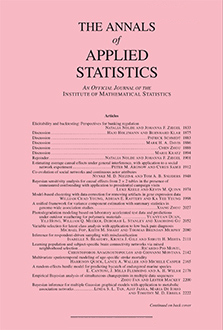Abstract
Tropospheric ozone is one of six criteria pollutants regulated by the US EPA, and has been linked to respiratory and cardiovascular endpoints and adverse effects on vegetation and ecosystems. Regional photochemical models have been developed to study the impacts of emission reductions on ozone levels. The standard approach is to run the deterministic model under new emission levels and attribute the change in ozone concentration to the emission control strategy. However, running the deterministic model requires substantial computing time, and this approach does not provide a measure of uncertainty for the change in ozone levels. Recently, a reduced form model (RFM) has been proposed to approximate the complex model as a simple function of a few relevant inputs. In this paper, we develop a new statistical approach to make full use of the RFM to study the effects of various control strategies on the probability and magnitude of extreme ozone events. We fuse the model output with monitoring data to calibrate the RFM by modeling the conditional distribution of monitoring data given the RFM using a combination of flexible semiparametric quantile regression for the center of the distribution where data are abundant and a parametric extreme value distribution for the tail where data are sparse. Selected parameters in the conditional distribution are allowed to vary by the RFM value and the spatial location. Also, due to the simplicity of the RFM, we are able to embed the RFM in our Bayesian hierarchical framework to obtain a full posterior for the model input parameters, and propagate this uncertainty to the estimation of the effects of the control strategies. We use the new framework to evaluate three potential control strategies, and find that reducing mobile-source emissions has a larger impact than reducing point-source emissions or a combination of several emission sources.
Citation
Brian Reich. Daniel Cooley. Kristen Foley. Sergey Napelenok. Benjamin Shaby. "Extreme value analysis for evaluating ozone control strategies." Ann. Appl. Stat. 7 (2) 739 - 762, June 2013. https://doi.org/10.1214/13-AOAS628
Information





